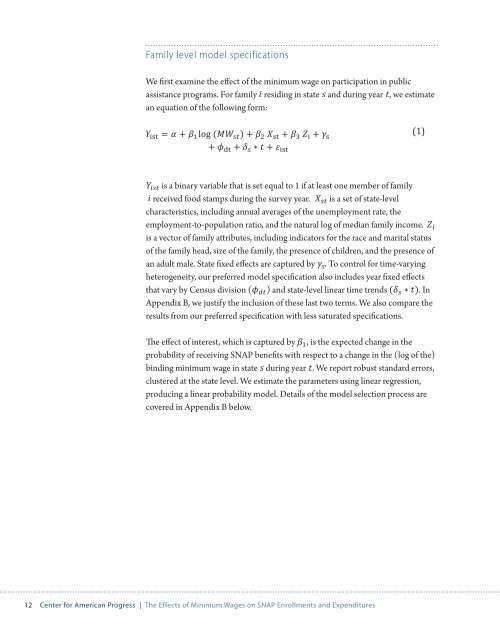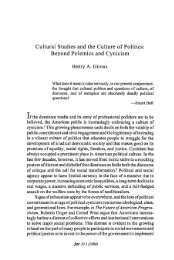effects-of-minimum-wages-on-snap
effects-of-minimum-wages-on-snap
effects-of-minimum-wages-on-snap
Create successful ePaper yourself
Turn your PDF publications into a flip-book with our unique Google optimized e-Paper software.
Family level model specificati<strong>on</strong>s<br />
We first examine the effect <str<strong>on</strong>g>of</str<strong>on</strong>g> the <str<strong>on</strong>g>minimum</str<strong>on</strong>g> wage <strong>on</strong> participati<strong>on</strong> in public<br />
assistance programs. For family residing in state and during year , we estimate<br />
an equati<strong>on</strong> <str<strong>on</strong>g>of</str<strong>on</strong>g> the following form:<br />
(1)<br />
is a binary variable that is set equal to 1 if at least <strong>on</strong>e member <str<strong>on</strong>g>of</str<strong>on</strong>g> family<br />
received food stamps during the survey year. is a set <str<strong>on</strong>g>of</str<strong>on</strong>g> state-level<br />
characteristics, including annual averages <str<strong>on</strong>g>of</str<strong>on</strong>g> the unemployment rate, the<br />
employment-to-populati<strong>on</strong> ratio, and the natural log <str<strong>on</strong>g>of</str<strong>on</strong>g> median family income.<br />
is a vector <str<strong>on</strong>g>of</str<strong>on</strong>g> family attributes, including indicators for the race and marital status<br />
<str<strong>on</strong>g>of</str<strong>on</strong>g> the family head, size <str<strong>on</strong>g>of</str<strong>on</strong>g> the family, the presence <str<strong>on</strong>g>of</str<strong>on</strong>g> children, and the presence <str<strong>on</strong>g>of</str<strong>on</strong>g><br />
an adult male. State fixed <str<strong>on</strong>g>effects</str<strong>on</strong>g> are captured by . To c<strong>on</strong>trol for time-varying<br />
heterogeneity, our preferred model specificati<strong>on</strong> also includes year fixed <str<strong>on</strong>g>effects</str<strong>on</strong>g><br />
that vary by Census divisi<strong>on</strong> ( ) and state-level linear time trends . In<br />
Appendix B, we justify the inclusi<strong>on</strong> <str<strong>on</strong>g>of</str<strong>on</strong>g> these last two terms. We also compare the<br />
results from our preferred specificati<strong>on</strong> with less saturated specificati<strong>on</strong>s.<br />
The effect <str<strong>on</strong>g>of</str<strong>on</strong>g> interest, which is captured by , is the expected change in the<br />
probability <str<strong>on</strong>g>of</str<strong>on</strong>g> receiving SNAP benefits with respect to a change in the (log <str<strong>on</strong>g>of</str<strong>on</strong>g> the)<br />
binding <str<strong>on</strong>g>minimum</str<strong>on</strong>g> wage in state during year . We report robust standard errors,<br />
clustered at the state level. We estimate the parameters using linear regressi<strong>on</strong>,<br />
producing a linear probability model. Details <str<strong>on</strong>g>of</str<strong>on</strong>g> the model selecti<strong>on</strong> process are<br />
covered in Appendix B below.<br />
12 Center for American Progress | The Effects <str<strong>on</strong>g>of</str<strong>on</strong>g> Minimum Wages <strong>on</strong> SNAP Enrollments and Expenditures




